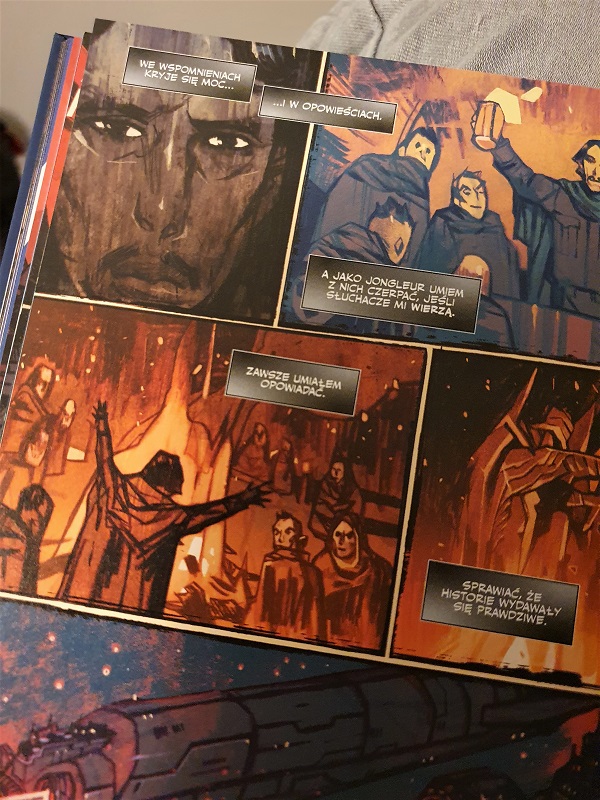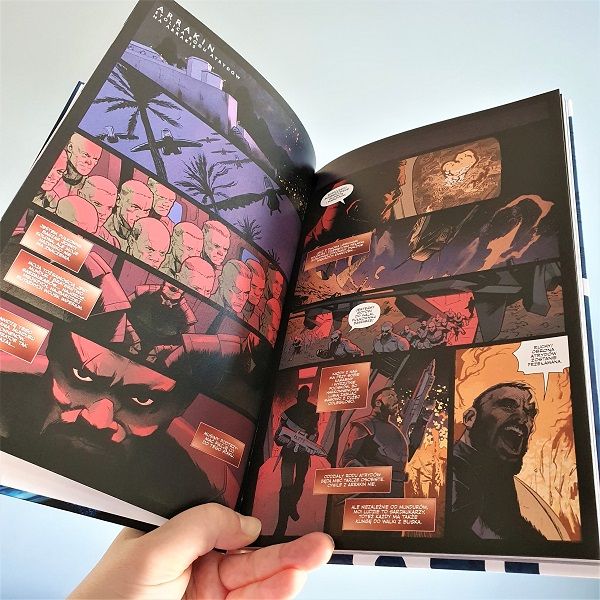One battle is thousands of tangled, dramatic fates. In this comic, you'll hear about two completely different characters: a Sardaukar and a faithful Atreides soldier. Sounds predictable?
Atrydzi i Harkonennowie
The starting point seems obvious here, after all, Dune basically tells the story of two houses that sincerely hate each other, and this conflict erupts in full force when the balance of power and supremacy over the only source of spice, oil and poppy seeds in the cosmos changes.
The stories in this volume do not have a point of contact, although they happen more or less at the same time. There is a battle that will be won by the Harkonenn and that will condemn the Atreides to desert exile. The victory is entirely due to the mercenaries, the Sardaukar, i.e. the elite troops of the Emperor himself. As you well know from the book or film adaptation, it is the result of complicated intrigues that will continue for a long time. Politics, imperial sympathies and ambitions, the question of ensuring a steady flow of the most important resource in the world to the Guild Navigators, the grand scheme of genetic modification of humanity … This is Frank Herbert’s epic vision. Meanwhile, the comic book by Herbert and Anderson, belonging to the so-called Extended Dune, is moving towards intimate stories.

Sardaukar is never wrong
The Emperor’s elite military is formed by the same method as the Imperial stormtrooper hordes: first roundup or jailbreaking, then deadly training, then maybe we’d better buy some clones… OK, clones are out of the question yet, just something like general recruitment for now unfortunates and outcasts. And also those whose families have fallen out of favor, as was the case with the narrator of the first story, Jopati Klony.
I can’t say that this novella sinned with great originality. Maybe I’m biased, as you might have guessed from my previous review of a comic from this universe , I don’t see the need to stuff Herbert’s work with details and change it into tearful, or even action-packed, subplots. Dune has a clear, almost philosophical, “issue” axis and a well-drawn plot revolving around the idea of bringing to life a kwisatz haderach , a future-seeing, enhanced human – plus plenty of fascinating more or less side-themes.
Sardaukar blood could happen in the Star Wars universe, on a Syndicate planet from the Jack Campbell series , or any other militarizing sci-fi. And even fantasy. Apart from proper names, nothing about it is typical of Arrakis or Dune in general. Besides, it’s a thoroughly drawn (Adam Gorham) comic with great colors by Patricio Delpeche. Here you will find sudden twists, you will learn a detail from the life of Duke Leto, but you could easily live without this knowledge.
Rebel for the Emperor!
I admit it without beating – I wanted this comic because of The Whisper of Caladan Seas drawn and colored by Rebel. I figured that even if the script was as generic as Genesis , I could handle it. Ultimately, I remember that story with tenderness, although I closed the file (greetings to the Scribd reading room) in a sense of gross frustration – fortunately, today I associate it almost exclusively with beautiful frames. Such illustrations can save the average scenario.
The second novel from Tales of Arrakeen is more interesting than the opening one. The main character is endowed with something like a Voice – he is a jongleur, an artist who can hypnotize the audience, tell stories in such an immersive way that the listeners move with him to the world of fiction. Again, this skill isn’t from the original trilogy or even Frank Herbert’s hexabook, and you could probably waste your nights discussing how much sense it makes in the context of the original Dune . The writers assure that it has, but it was not mentioned because it is banned and something of a taboo. Hence the main dramatic axis of Whisper – the talented Sergeant Vitt is not sure if he has the right to use his gift even in dramatic circumstances.
The Caladan fragments, so told by the jongleur, may not be too engaging, but the entire Rebel comic is. The melancholic mood is intensified by the Byzantine sad faces of the characters and their robes arranged on them as in El Greco, you will find the mood of Judas here . Color changes, transitions from dramatic reds and oranges (battle and old heroic tales), through grays to the blues of Caladan, show the changes of tension in the narrative much more interestingly than assumed in the script based on Vitto’s doubts. Rebelka turned the novel into a beautiful, scary and sad dream.
Two stories, both well illustrated, but only one will stay in my mind for longer, thanks to the additional meanings carried by the illustrations. Dune. Tales from Arrakeen is definitely a position for fans: both Herberts or Jakub Rebelka. And probably only such people will be really happy with the comic.


